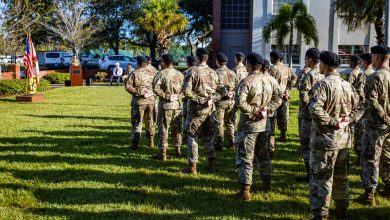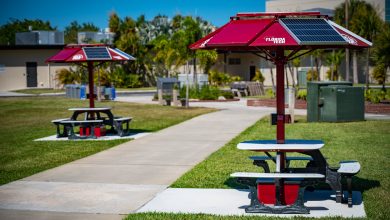Students Design Award-Winning Solution to U.S. Navy’s Transportation Woes
The U.S. Navy often finds that its equipment gets damaged during transportation so a team of mechanical engineering majors designed a solution to protect this valuable cargo.
Together, Quintcey Parrish, Chris Ballentine, Christopher Dixon, Kyle Koren, Adam Madison, Reid Neal designed a special protective plate that provides a novel buffering solution for the Navy’s heavy equipment.
Their Scuff Protection Interface (SPI) is a plate that is half an inch thick, five inches wide, and sixty-inch long that uses a geometric pattern to secure heavy objects together.
“Our innovative design solution was to make the plate in two sections. The top section is steel, which is welded onto the Navy equipment as a permanent fixture. The bottom section is Bearing Grade Nylon, which is a wearable and replaceable material that can be easily machined and replaced,” said Parrish.
The two sections fit together by a reciprocal patterned geometry that allows the sections to piece together without exceeding the geometric requirements. This provided a way for the Navy to secure equipment without the need for fasteners.
“The world of polymer research is an undeveloped field. We created our own testing system and conducted experiments on wear of various polymers. During the project we hit the tip of the ice berg; this research will be continued by one of our teammates next semester for a graduate level thesis.”
The team’s final project has applications beyond the Navy’s needs and can be applied to any high loading or sliding scenario’s faced by any organization that transports heavy equipment. It could even be applied to the home with windows and sliding glass doors.
“We interfaced with Lockheed Martin every week, and we presented our work to a Lieutenant Commander of the Navy at the end of each semester. Having the opportunity to work with a customer and see a project from requirements to completion has helped give us the confidence and ability required to move forward into the work force,” said Parrish.
One of the biggest surprises the team encountered was that it contradicted what they thought a mechanical engineering project would be — their final project ended up did not have any moving parts or electrical system.
“From this our team learned the importance of design, and we realized that what we build does not always have to be our final product.”
The final product ended up blowing the judges away at the 2018 Northrop Grumman Engineering and Science Student Design Showcase. Not only did they win for their category in mechanical engineering, but they also won the President’s Cup for engineering.
“This project would not have been a success without such a great team. Our team was motivated from day one to succeed, and we supported each other through the intense year. After spending a whole year together, we still spend time together despite the project being completed.”
University judges and faculty were so impressed with the project, they nominated the team to attend the 2018 Florida-Wide Student Engineering Design Invitational hosted at UCF.
The team took home “Best Invited Project” at the inaugural event.
“Upon attending the UCF showcase against other schools from across Florida, it was clear that the Florida Tech standards are high. What we (the senior design students) consider to be the normal expectation is levels above the standards that I from the other schools. We are lucky to have such great faculty and facilities promoting and challenging us to succeed.”









